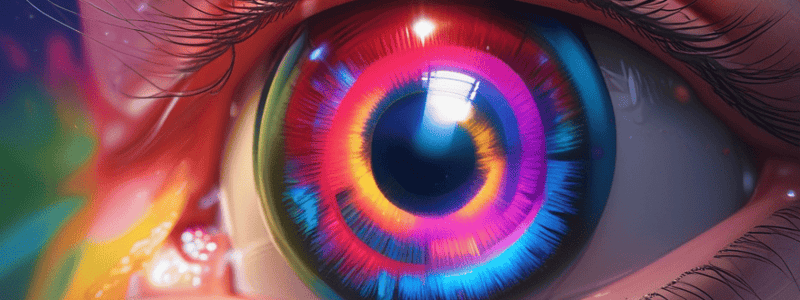Podcast
Questions and Answers
What is the range of wavelengths for visible light?
What is the range of wavelengths for visible light?
- 200 nm to 500 nm
- 400 nm to 700 nm (correct)
- 300 nm to 800 nm
- 600 nm to 900 nm
Which statement about perceived color is correct?
Which statement about perceived color is correct?
- Perceived color is the wavelength that is absorbed by objects
- Perceived color is the wavelength that is refracted by objects
- Perceived color is the wavelength that is reflected by objects (correct)
- Perceived color is the wavelength that is diffracted by objects
What happens when ciliary muscles are relaxed?
What happens when ciliary muscles are relaxed?
- Suspensory ligaments relax, and the lens flattens
- Suspensory ligaments pull, and the lens rounds
- Suspensory ligaments relax, and the lens rounds
- Suspensory ligaments pull, and the lens flattens (correct)
Which part of the eye is responsible for adjusting the lens strength?
Which part of the eye is responsible for adjusting the lens strength?
What is the legal definition of blindness?
What is the legal definition of blindness?
What is the cause of nearsightedness (myopia)?
What is the cause of nearsightedness (myopia)?
Which type of lens is used to correct farsightedness (hyperopia)?
Which type of lens is used to correct farsightedness (hyperopia)?
What is the purpose of the Snellen eye chart?
What is the purpose of the Snellen eye chart?
What is the function of the optic chiasm?
What is the function of the optic chiasm?
What happens in the case of a unilateral optic nerve lesion?
What happens in the case of a unilateral optic nerve lesion?
What is the primary role of lateral inhibition in the retina?
What is the primary role of lateral inhibition in the retina?
Which cells in the retina are responsible for converting light stimuli into electrical signals?
Which cells in the retina are responsible for converting light stimuli into electrical signals?
How does the brain perceive depth perception?
How does the brain perceive depth perception?
What is the approximate ratio of rods to cones in the human retina?
What is the approximate ratio of rods to cones in the human retina?
What is the process of convergence in the visual system?
What is the process of convergence in the visual system?
Which cells in the retina transmit signals to the brain via the optic nerve?
Which cells in the retina transmit signals to the brain via the optic nerve?
What is the main function of the optic disc?
What is the main function of the optic disc?
Which type of photopigment is found in the rod membrane?
Which type of photopigment is found in the rod membrane?
Where is the metabolic machinery of the cell located in a photoreceptor?
Where is the metabolic machinery of the cell located in a photoreceptor?
What is the function of the synaptic terminal in a photoreceptor?
What is the function of the synaptic terminal in a photoreceptor?
Which photopigment is associated with cones responsible for color vision?
Which photopigment is associated with cones responsible for color vision?
What is the main difference between rods and cones regarding light sensitivity?
What is the main difference between rods and cones regarding light sensitivity?
How does light affect signal transduction in the visual system?
How does light affect signal transduction in the visual system?
Which of the following statements about the opponent-process theory is correct?
Which of the following statements about the opponent-process theory is correct?
Which of the following is NOT a type of color blindness mentioned in the text?
Which of the following is NOT a type of color blindness mentioned in the text?
What is the primary function of the pupillary sphincter?
What is the primary function of the pupillary sphincter?
Which of the following statements about light sensitivity is correct?
Which of the following statements about light sensitivity is correct?
What happens when the eye is exposed to intense light, such as sunlight?
What happens when the eye is exposed to intense light, such as sunlight?
Which process allows the eye to adapt to the absence of light (dark conditions)?
Which process allows the eye to adapt to the absence of light (dark conditions)?
What is the term used to describe the process of moving from a dark environment to a bright one?
What is the term used to describe the process of moving from a dark environment to a bright one?
What happens to the image perceived by the eye when moving from a dark environment to a bright one?
What happens to the image perceived by the eye when moving from a dark environment to a bright one?
Which of the following statements about the pupillary dilator is correct?
Which of the following statements about the pupillary dilator is correct?
Which nervous system controls the contraction of the pupillary sphincter?
Which nervous system controls the contraction of the pupillary sphincter?
Flashcards are hidden until you start studying




